Related Research Articles

Following the discovery of the planet Neptune in 1846, there was considerable speculation that another planet might exist beyond its orbit. The search began in the mid-19th century and continued at the start of the 20th with Percival Lowell's quest for Planet X. Lowell proposed the Planet X hypothesis to explain apparent discrepancies in the orbits of the giant planets, particularly Uranus and Neptune, speculating that the gravity of a large unseen ninth planet could have perturbed Uranus enough to account for the irregularities.

A ring system is a disc or torus orbiting an astronomical object that is composed of solid material such as gas, dust, meteoroids, planetoids or moonlets and stellar objects.

Pluto is a dwarf planet in the Kuiper belt, a ring of bodies beyond the orbit of Neptune. It is the ninth-largest and tenth-most-massive known object to directly orbit the Sun. It is the largest known trans-Neptunian object by volume, by a small margin, but is less massive than Eris. Like other Kuiper belt objects, Pluto is made primarily of ice and rock and is much smaller than the inner planets. Pluto has roughly one-sixth the mass of the Moon, and one-third its volume.

2060 Chiron is a ringed small Solar System body in the outer Solar System, orbiting the Sun between Saturn and Uranus. Discovered in 1977 by Charles Kowal, it was the first-identified member of a new class of objects now known as centaurs—bodies orbiting between the asteroid belt and the Kuiper belt. Chiron is named after the centaur Chiron in Greek mythology.

Lowell Observatory is an astronomical observatory in Flagstaff, Arizona, United States. Lowell Observatory was established in 1894, placing it among the oldest observatories in the United States, and was designated a National Historic Landmark in 1965. In 2011, the Observatory was named one of "The World's 100 Most Important Places" by Time Magazine. It was at the Lowell Observatory that the dwarf planet Pluto was discovered in 1930 by Clyde Tombaugh.

An occultation is an event that occurs when one object is hidden from the observer by another object that passes between them. The term is often used in astronomy, but can also refer to any situation in which an object in the foreground blocks from view (occults) an object in the background. In this general sense, occultation applies to the visual scene observed from low-flying aircraft when foreground objects obscure distant objects dynamically, as the scene changes over time.

28978 Ixion (, provisional designation 2001 KX76) is a large trans-Neptunian object and a possible dwarf planet. It is located in the Kuiper belt, a region of icy objects orbiting beyond Neptune in the outer Solar System. Ixion is classified as a plutino, a dynamical class of objects in a 2:3 orbital resonance with Neptune. It was discovered in May 2001 by astronomers of the Deep Ecliptic Survey at the Cerro Tololo Inter-American Observatory, and was announced in July 2001. The object is named after the Greek mythological figure Ixion, who was a king of the Lapiths.
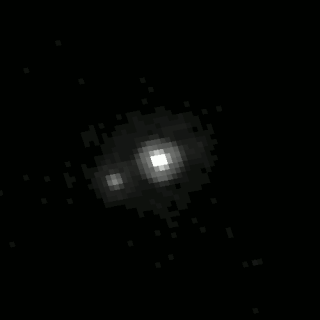
Orcus is a dwarf planet located in the Kuiper belt, with one large moon, Vanth. It has an estimated diameter of 870 to 960 km, comparable to the Inner Solar System dwarf planet Ceres. The surface of Orcus is relatively bright with albedo reaching 23 percent, neutral in color, and rich in water ice. The ice is predominantly in crystalline form, which may be related to past cryovolcanic activity. Other compounds like methane or ammonia may also be present on its surface. Orcus was discovered by American astronomers Michael Brown, Chad Trujillo, and David Rabinowitz on 17 February 2004.
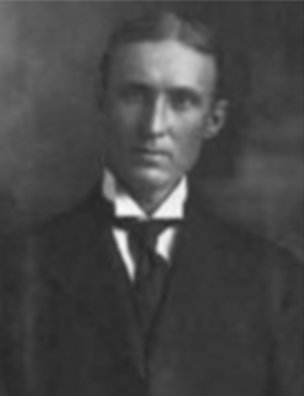
Carl Otto Lampland was an American astronomer. He was involved with both of the Lowell Observatory solar system projects, observations of the planet Mars and the search for Planet X.

38628 Huya ( hoo-YAH; provisional designation 2000 EB173) is a binary trans-Neptunian object located in the Kuiper belt, a region of icy objects orbiting beyond Neptune in the outer Solar System. Huya is classified as a plutino, a dynamical class of trans-Neptunian objects with orbits in a 3:2 orbital resonance with Neptune. It was discovered by the Quasar Equatorial Survey Team and was identified by Venezuelan astronomer Ignacio Ferrín in March 2000. It is named after Juyá, the mythological rain god of the Wayuu people native to South America.
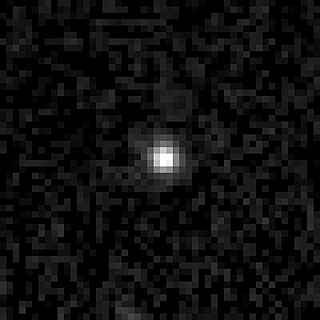
10199 Chariklo is the largest confirmed centaur, a class of minor planet in the outer Solar System. It orbits the Sun between Saturn and Uranus, grazing the orbit of Uranus. On 26 March 2014, astronomers announced the discovery of two rings around Chariklo by observing a stellar occultation, making it the first minor planet known to have rings.
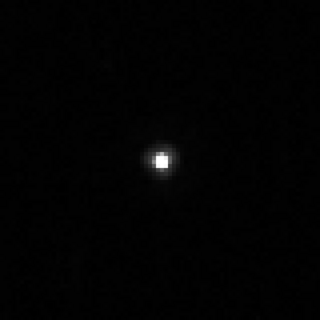
(307261) 2002 MS4 (provisional designation 2002 MS4) is a large trans-Neptunian object in the Kuiper belt, which is a region of icy planetesimals beyond Neptune. It was discovered on 18 June 2002 by Chad Trujillo and Michael Brown during their search for bright, Pluto-sized Kuiper belt objects at Palomar Observatory. To within measurement uncertainties, 2002 MS4, 2002 AW197, and 2013 FY27 have a diameter close to 800 km (500 mi), which makes them the largest unnamed objects in the Solar System. 2002 MS4 is large enough that some astronomers conclude that it might be a dwarf planet.
James Ludlow Elliot was an American astronomer and scientist who, as part of a team, discovered the rings around the planet Uranus. Elliot was also part of a team that observed global warming on Triton, the largest moon of Neptune.

229762 Gǃkúnǁʼhòmdímà (provisional designation 2007 UK126) is a trans-Neptunian object and binary system from the extended scattered disc, located in the outermost region of the Solar System. It was discovered on 19 October 2007 by American astronomers Megan Schwamb, Michael Brown, and David Rabinowitz at the Palomar Observatory in California and measures approximately 600 kilometers (400 miles) in diameter. This medium-sized TNO appears to be representative of a class of mid-sized objects under approximately 1000 km that have not collapsed into fully solid bodies. Its 100-kilometer moon was discovered by Keith Noll, Will Grundy, and colleagues with the Hubble Space Telescope in 2008, and named Gǃòʼé ǃHú.

Discovery and exploration of the Solar System is observation, visitation, and increase in knowledge and understanding of Earth's "cosmic neighborhood". This includes the Sun, Earth and the Moon, the major planets Mercury, Venus, Mars, Jupiter, Saturn, Uranus, and Neptune, their satellites, as well as smaller bodies including comets, asteroids, and dust.
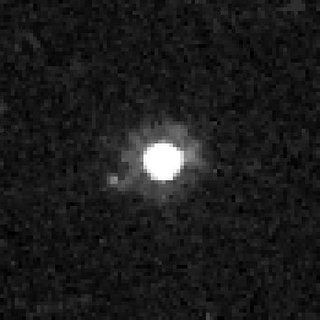
Quaoar is a large, ringed dwarf planet in the Kuiper belt, a region of icy planetesimals beyond Neptune. It has an elongated ellipsoidal shape with an average diameter of 1,090 km (680 mi), about half the size of the dwarf planet Pluto. The object was discovered by American astronomers Chad Trujillo and Michael Brown at the Palomar Observatory on 4 June 2002. Quaoar's surface contains crystalline water ice and ammonia hydrate, which suggests that it might have experienced cryovolcanism. A small amount of methane is present on its surface, which can only be retained by the largest Kuiper belt objects.
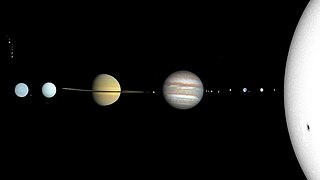
The following outline is provided as an overview of and topical guide to the Solar System:

The rings of Chariklo are a set of two narrow rings around the minor planet 10199 Chariklo. Chariklo, with a diameter of about 250 kilometres (160 mi), is the second-smallest celestial object with confirmed rings and the fifth ringed celestial object discovered in the Solar System, after the gas giants and ice giants. Orbiting Chariklo is a bright ring system consisting of two narrow and dense bands, 6–7 km (4 mi) and 2–4 km (2 mi) wide, separated by a gap of 9 kilometres (6 mi). The rings orbit at distances of about 400 kilometres (250 mi) from the centre of Chariklo, a thousandth the distance between Earth and the Moon. The discovery was made by a team of astronomers using ten telescopes at various locations in Argentina, Brazil, Chile and Uruguay in South America during observation of a stellar occultation on 3 June 2013, and was announced on 26 March 2014.

Elizabeth Langdon Williams was an American human computer and astronomer whose work helped lead to the discovery of Pluto, or Planet X.
Centaurus is a mission concept to flyby the centaurs 2060 Chiron and Schwassmann–Wachmann 1. It was submitted in response to the NASA Discovery program call for proposals in 2019 but ultimately was not among the four missions selected for further development by NASA in February 2020. If it had been selected, Centaurus would have been the first mission to attempt a flyby of a centaur.
References
- ↑ Schindler, Kevin (2024-10-17). "Lowell Observatory Welcomes New Executive Director Dr. Amanda Bosh". Lowell Observatory. Retrieved 2024-12-01.
- 1 2 3 "Amanda Bosh promoted to senior lecturer". MIT News | Massachusetts Institute of Technology. 2015-09-25. Retrieved 2023-11-28.
- ↑ Bosh, Amanda Sachie. Stellar Occultation Studies of Saturn’s Rings with the Hubble Space Telescope. Massachusetts Institute of Technology, Department of Earth, Atmospheric, and Planetary Sciences, 1994.
- 1 2 "Dr. Amanda Bosh". Lowell Observatory. Retrieved 2023-11-28.
- ↑ Schindler, Kevin (2024-10-17). "Lowell Observatory Welcomes New Executive Director Dr. Amanda Bosh". Lowell Observatory. Retrieved 2024-12-01.
- ↑ "Stellar Occultations". occult.mit.edu. Retrieved 2023-12-04.
- ↑ Elliot, J. L.; Dunham, E.; Mink, D. (May 1977). "The rings of Uranus". Nature. 267 (5609): 328–330. Bibcode:1977Natur.267..328E. doi:10.1038/267328a0. ISSN 1476-4687. S2CID 4194104.
- ↑ Observatory, Kevin Schindler, Lowell (2015-06-03). "How a flying telescope proved Pluto has an atmosphere | Astronomy.com". Astronomy Magazine. Retrieved 2023-12-04.
{{cite web}}: CS1 maint: multiple names: authors list (link) - ↑ "What is an occultation? « IOTA". occultations.org. Retrieved 2023-12-04.
- ↑ Chu, Jennifer; Technology, Massachusetts Institute of. "NASA mission chases Pluto's shadow to catch details of its atmosphere". phys.org. Retrieved 2023-11-28.
- ↑ "SOFIA Overview - NASA Science". science.nasa.gov. Retrieved 2023-12-04.
- 1 2 3 4 "Q&A: Catching Pluto's shadow". MIT News | Massachusetts Institute of Technology. 2015-07-08. Retrieved 2023-12-04.
- ↑ "Small-Body Database Lookup". ssd.jpl.nasa.gov. Retrieved 2023-12-04.
- ↑ "A second minor planet may possess Saturn-like rings". MIT News | Massachusetts Institute of Technology. 2015-03-17. Retrieved 2023-12-04.
- ↑ Sickafoose, Amanda A.; Levine, Stephen E.; Bosh, Amanda S.; Person, Michael J.; Zuluaga, Carlos A.; Knieling, Bastian; Lewis, Mark C.; Schindler, Karsten (2023-11-28). "Material around the Centaur (2060) Chiron from the 2018 November 28 UT Stellar Occultation". The Planetary Science Journal. 4 (11): 221. arXiv: 2310.16205 . Bibcode:2023PSJ.....4..221S. doi: 10.3847/PSJ/ad0632 . ISSN 2632-3338.
- ↑ "Winners of 2020 Teaching With Digital Technology Award recognized for their innovations". MIT News | Massachusetts Institute of Technology. 2020-09-09. Retrieved 2023-11-28.
- 1 2 "Native American Astronomy Outreach Program". Lowell Observatory. Retrieved 2023-12-04.
- ↑ Reporter, EMERY COWAN Sun Staff (2015-07-09). "Lowell scientists peer into Pluto's atmosphere". Arizona Daily Sun. Retrieved 2023-12-04.